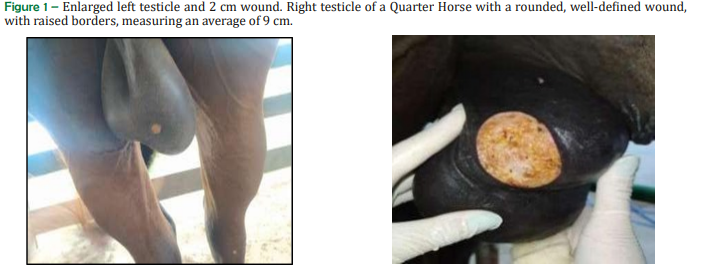Anhidrosis in a horse - case report
DOI:
https://doi.org/10.21708/avb.2025.19.1.12531Resumo
Equine anhidrosis is the inability of the animal to sweat appropriately upon stimuli, which may lead to serious heat stress problems and consequent reproductive problems such as testicular degeneration. Anhidrosis has a high prevalence in animals kept in hot and humid environments and its pathogenesis may be related to a progressive failure in the secretory process, glandular degeneration or reduction in the responses of the glands in contact with adrenaline. The disorder can be considered partial or complete, and the main clinical signs are those related to heat stress such as hyperthermia, tachypnoea, apathy, lethargy, anorexia and dermatological problems. The diagnosis is made using semi-quantitative intradermal adrenaline or β2 agonist tests. The management of this condition should mainly involve removing the animal from the stress-inducing environment.
Downloads

Downloads
Publicado
Edição
Seção
Licença
Copyright (c) 2025 Acta Veterinaria Brasilica

Este trabalho está licenciado sob uma licença Creative Commons Attribution 4.0 International License.
Autores que publicam na Acta Veterinaria Brasilica concordam com os seguintes termos: a) Autores mantém os direitos autorais e concedem à revista o direito de primeira publicação, com o trabalho simultaneamente licenciado sob a Licença Creative Commons Attribution que permite o compartilhamento do trabalho com reconhecimento da autoria e publicação inicial nesta revista. b) Autores têm autorização para assumir contratos adicionais separadamente, para distribuição não-exclusiva da versão do trabalho publicada nesta revista (ex.: publicar em repositório institucional ou como capítulo de livro), com reconhecimento de autoria e publicação inicial nesta revista. c) Autores têm permissão e são estimulados a publicar e distribuir seu trabalho online (ex.: em repositórios institucionais ou na sua página pessoal) a qualquer ponto antes ou durante o processo editorial, já que isso pode gerar alterações produtivas, bem como aumentar o impacto e a citação do trabalho publicado (Veja O Efeito do Acesso Livre).


 Esta obra está licenciada com uma Licença
Esta obra está licenciada com uma Licença 